Microstructure and Mechanical Properties of GH4169 Superalloy and Si3N4 Ceramic Joints Brazed with AgCuTi/Cu foam/AgCuTi Composited Filler
Abstract
1. Introduction
2. Materials and Methods
3. Results and Discussion
3.1. Microstructure of the GH4169/Si3N4 Joints
3.2. Effect of Brazing Temperature on the GH4169/Si3N4 Joint
3.3. Effect of Brazing Temperature on the Mechanical Properties of the GH4169/Si3N4 Joint
4. Conclusions
- (1)
- The GH4169/Si3N4 joints can be divided into three zones. The microstructure of the joint is GH4169 superalloy/TiCu+Ti2Ni+TiCu2+Ag (s,s)+TiCu4+Cu (s,s)+TiN+Ti5Si3/ Si3N4 ceramics.
- (2)
- During brazing, the Ti elements in the AgCuTi filler would react with the substrate. The aggregate on the side of the GH4169 superalloy to form Ti-Cu intermetallic compounds and a continuous reaction layer of TiN and Ti5Si3 were formed. With the gradual dissolution of Cu foam, and the content of Cu (s, s) in the joint is reduced. The increase in Ag (s, s), Cu (s, s) and reaction layer thickness in the joint is conducive to the improvement of the mechanical properties of the joint.
- (3)
- At 850 °C, the shear strength of the joint reaches a maximum of 196.85 MPa. With the increase in brazing temperature, the skeleton of Cu foam disappeared, and the volume fraction of Ti-Cu intermetallic compounds increased, which is harmful to the mechanical properties.
Author Contributions
Funding
Institutional Review Board Statement
Informed Consent Statement
Data Availability Statement
Conflicts of Interest
References
- Fei, S.O.; Ryotaro, N.; Hirobumi, T.; Eiichi, S. Strength optimization of two-step-bonded Ti-6Al-4V/Si3N4 joint with Nb interlayer via transient-liquid-phase bonding and active-metal brazing. J. Eur. Ceram. Soc. 2022, 42, 2707–2717. [Google Scholar]
- Li, M.; Shi, K.Q.; Zhu, D.D.; Dong, D.; Liu, L.; Wang, X.H. Microstructure and mechanical properties of Si3N4 ceramic and (TiB+Y2O3)/Ti matrix composite joints brazed with AgCu/Cu foam/AgCu multilayered filler. J. Manuf. Process. 2021, 66, 220–227. [Google Scholar] [CrossRef]
- Wei, C.C.; Zhang, Z.Y.; Ma, X.F.; Liu, L.Y. Mechanical and ablation properties of laminated ZrB2-SiC ceramics with Si3N4 whisker interface. Corros. Sci. 2022, 197, 110051. [Google Scholar] [CrossRef]
- Zhang, Z.Q.; Shi, K.Q.; Huang, X.C.; Shi, Y.Y. Development of a probabilistic algorithm of surface residual materials on Si3N4 ceramics under longitudinal torsional ultrasonic grinding. Ceram. Int. 2022, 48, 12028–12037. [Google Scholar] [CrossRef]
- Zhang, Z.; Li, J.N.; Sun, X.G.; Ma, F.K. Microstructure performance enhancement of Si3N4 reinforced laser clad KF110 base composite coatings. Int. J. Appl. Ceram. Technol. 2022, 19, 409–414. [Google Scholar] [CrossRef]
- Srivastava, A.K.; Dwivedi, S.; Saxena, A.; Kumar, D. Tribological Characteristics of Al359/Si3N4/Eggshell Surface Composite Produced by Friction Stir Processing. Coatings 2022, 12, 1362. [Google Scholar] [CrossRef]
- Kour, P.; Pradhan, S.K.; Kumar, A.; Kar, M. Machining by Advanced Ceramics Tools: Challenges and Opportunities. In Advances in Sustainable Machining and Manufacturing Processes; CRC Press: Boca Raton, FL, USA, 2022; Volume 14, pp. 17–30. [Google Scholar]
- Gao, W.; Wang, L.Q.; Jin, Y.H.; Yao, Y.H. Effect of Si3N4/TaC Particles on the Structure and Properties of Microarc Oxidation Coatings on TC4 Alloy. Coatings 2022, 12, 1247. [Google Scholar] [CrossRef]
- Salmi, M. Additive manufacturing processes in medical applications. Materials 2021, 14, 191. [Google Scholar] [CrossRef]
- Zhang, J.Y.; Yan, M.W.; Sun, G.C.; Liu, L.Q. An environment-friendly Fe3O4@CFAS porous ceramic: Adsorption of Cu(II) ions and process optimisation using response surface methodology. Ceram. Int. 2021, 476, 8256–8264. [Google Scholar] [CrossRef]
- Dubois, P.K.; Landry, C.; Thibault, D.; Plante, J.S. Benefits and Challenges of the Inside-Out Ceramic Turbine: An Experimental Assessment. J. Propuls. Power 2022, 38, 221–228. [Google Scholar] [CrossRef]
- Zhao, Y.X.; Bian, H.; Fu, W.; Hu, Y. Laser-induced metallization of porous Si3N4 ceramic and its brazing to TiAl alloy. J. Am. Ceram. Soc. 2019, 102, 32–36. [Google Scholar] [CrossRef]
- Guo, W.; Zhang, H.Q.; Ma, K.T.; Zhu, Y. Reactive brazing of silicon nitride to Invar alloy using Ni foam and AgCuTi intermediate layers. Ceram. Int. 2019, 45, 13979–13987. [Google Scholar] [CrossRef]
- Ahn, B. Recent advances in brazing fillers for joining of dissimilar materials. Metals 2021, 11, 1037. [Google Scholar] [CrossRef]
- Zheng, J.J.; Guo, Y.; Liu, X.; Zhang, Z.T. Introduction on Research and Application of Nickel Base Superalloy GH4169. IOP Conf. Ser. Earth Environ. Sci. 2021, 651, 022081. [Google Scholar] [CrossRef]
- Xiao, G.J.; Xing, J.Z.; Zhang, Y.D. Surface roughness prediction model of GH4169 superalloy abrasive belt grinding based on multilayer perceptron(MLP). Procedia Manuf. 2021, 54, 269–273. [Google Scholar] [CrossRef]
- Chen, W.; Zhang, P.; Xie, J.; Liu, Y. Metallurgical Analysis of different processing technologies on tensile behavior of GH4169 superalloy. IOP Conf. Ser. Earth Environ. Sci. 2021, 772, 012066. [Google Scholar] [CrossRef]
- Seleznev, A.; Pinargote, N.W.S.; Smirnov, A. Ceramic Cutting Materials and Tools Suitable for Machining High-Temperature Nickel-Based Alloys: A Review. Metals 2021, 11, 1385. [Google Scholar] [CrossRef]
- Guo, W.; Li, K.; Zhang, H.Q.; Zhu, Y. Low residual stress C/C composite-titanium alloy joints brazed by foam interlayer. Ceram. Int. 2022, 48, 5260–5266. [Google Scholar] [CrossRef]
- Wang, G.; Cai, Y.J.; Wang, W.; Gui, K.X.; Zhu, D.D.; Tan, C.W.; Cao, W. Brazing ZrB2-SiC ceramics to Inconel 600 alloy without and with Cu foam. J. Manuf. Process. 2019, 41, 29–35. [Google Scholar] [CrossRef]
- Wang, X.Y.; Li, C.; Si, X.Q.; Qi, J.L. Brazing ZTA ceramic to TC4 alloy using the Cu foam as interlayer. Vacuum 2018, 155, 7–15. [Google Scholar] [CrossRef]
- Liu, G.P.; Li, Y.L.; Long, W.F.; Hu, X.W. Wetting kinetics and spreading phenomena of the precursor film and bulk liquid in the AgCuTi/TC4 system. J. Alloys Compd. 2019, 802, 345–354. [Google Scholar] [CrossRef]
- Zhao, Y.X.; Song, X.G.; Tan, C.W.; Hu, S.P. Microstructural evolution of Si3N4/Ti6Al4V joints brazed with nano-Si3N4 reinforced AgCuTi composite filler. Vacuum 2017, 142, 58–65. [Google Scholar] [CrossRef]
- Gui, X.Y.; Zhang, M.F.; Zhang, X.T.; Guo, Q.H. Theoretical Investigations on Interfacial Behavior of Ag–Cu–Ti/Si3N4 Wetting System. J. Nanoelectron. Optoelectron. 2021, 16, 1780–1790. [Google Scholar] [CrossRef]
- Dong, D.; Zhu, D.D.; Wang, Y.; Wang, G.; Wu, P. Microstructure and shear strength of brazing TiAl/Si3N4 joints with Ag-Cu binary alloy as filler metal. Metals 2018, 8, 896. [Google Scholar] [CrossRef]
- Zhang, Y.; Guo, X.M.; Guo, W.; Zhang, H.Q. Effect of Cu foam on the microstructure and strength of the SiCf/SiC-GH536 brazed joint. Ceram. Int. 2022, 48, 12945–12953. [Google Scholar] [CrossRef]
- Guo, X.J.; SI, X.Q.; Li, C.; Zhao, S.H.; Liu, Y.X. Active brazing of C/C composites and single crystal Ni-based superalloy: Interfacial microstructure and formation mechanism. J. Alloys Compd. 2021, 886, 161183. [Google Scholar] [CrossRef]
- Xin, C.L.; Yan, J.Z.; Wang, Q.Y.; Feng, W. The microstructural evolution and formation mechanism in Si3N4/AgCuTi/Kovar braze joints. J. Alloys Compd. 2020, 820, 153189. [Google Scholar] [CrossRef]
- Wang, Y.; Jin, C.K.; Yang, Z.W.; Wang, D.P. Effects of Cu interlayers on the microstructure and mechanical properties of Al2O3/AgCuTi/Kovar brazed joints. Int. J. Appl. Ceram. Technol. 2019, 16, 896–906. [Google Scholar] [CrossRef]
- Wang, G.; Cai, Y.; Xu, Q.; Zhou, C. Microstructural and mechanical properties of inconel 600/ZrB2-SiC joints brazed with AgCu/Cu-foam/AgCu/Ti multi-layered composite filler. J. Mater. Res. Technol. 2020, 9, 3430–3437. [Google Scholar] [CrossRef]
- Wang, Z.; Wang, G.; Li, M.; Lin, J.M. Three-dimensional graphene-reinforced Cu foam interlayer for brazing C/C composites and Nb. J. Carbon. 2017, 118, 723–730. [Google Scholar] [CrossRef]
- Li, M.N.; Wang, Z.Y.; Ba, J.; Ma, Q. In-Situ synthesized TiC nano-flakes reinforced C/C composite-Nb brazed joint. J. Eur. Ceram. Soc. 2018, 38, 1059–1068. [Google Scholar]
- Guo, W.; Xue, J.L.; Zhang, H.Q.; Cui, H. The role of foam on microstructure and strength of the brazed C/C composites/Ti6Al4V alloy joint. Vacuum 2020, 179, 109543. [Google Scholar] [CrossRef]
- Zahri, N.A.M.; Yusof, F.; Miyashita, Y.; Ariga, T. Brazing of porous copper foam/copper with amorphous Cu-9.7Sn-5.7Ni-7.0P (wt%) filler metal: Interfacial microstructure and diffusion behavior. Weld. World 2020, 64, 209–217. [Google Scholar] [CrossRef]
- Ahmed, S.A.; Hasanabadi, M.F.; Kumar, A.V. Joining of ceramic to metal by friction welding process: A review. Proc. Inst. Mech. Eng. Part L-J. Mater.-Des. Appl. 2021, 235, 1723–1736. [Google Scholar] [CrossRef]
- Wang, Y.; Yang, Z.W.; Zhang, L.X.; Feng, J.C. Microstructure and Mechanical Properties of Invar Alloy and Si3N4 Ceramic Brazed Joints. Rare Met. Mater. Eng. 2015, 44, 339–343. [Google Scholar]


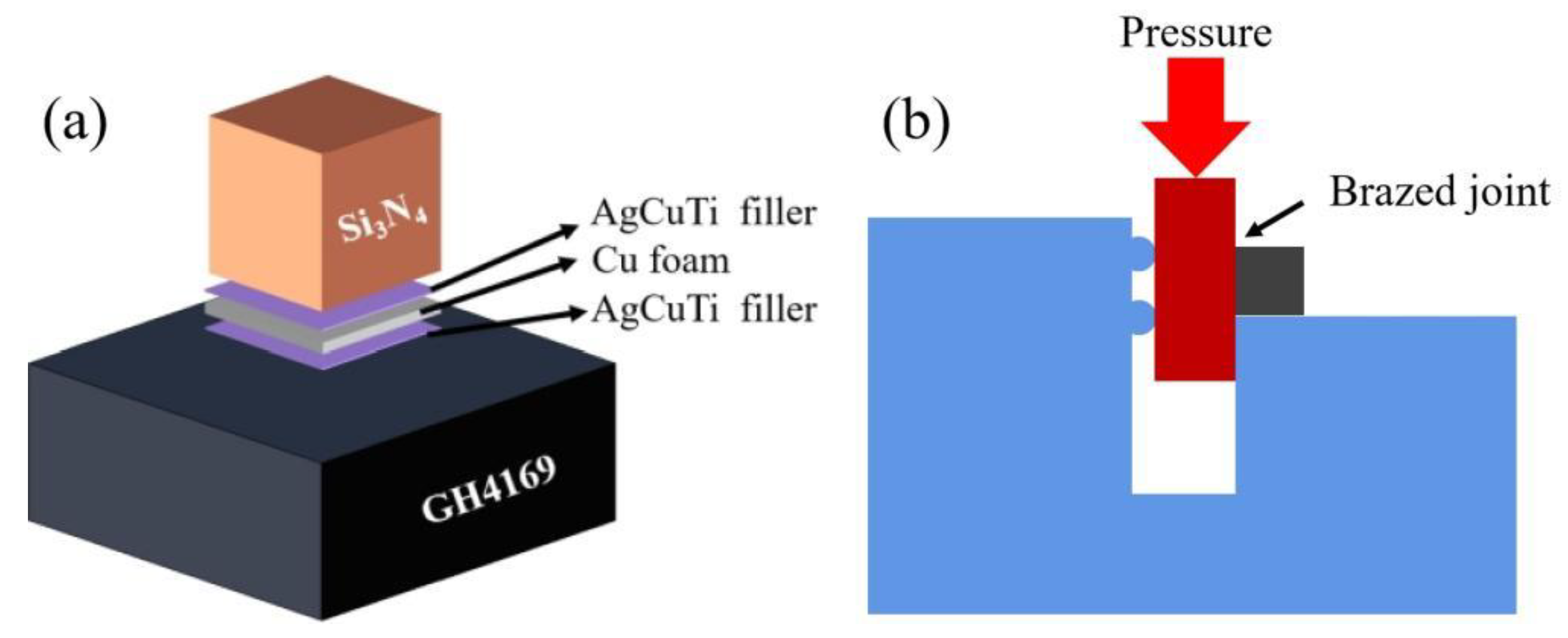

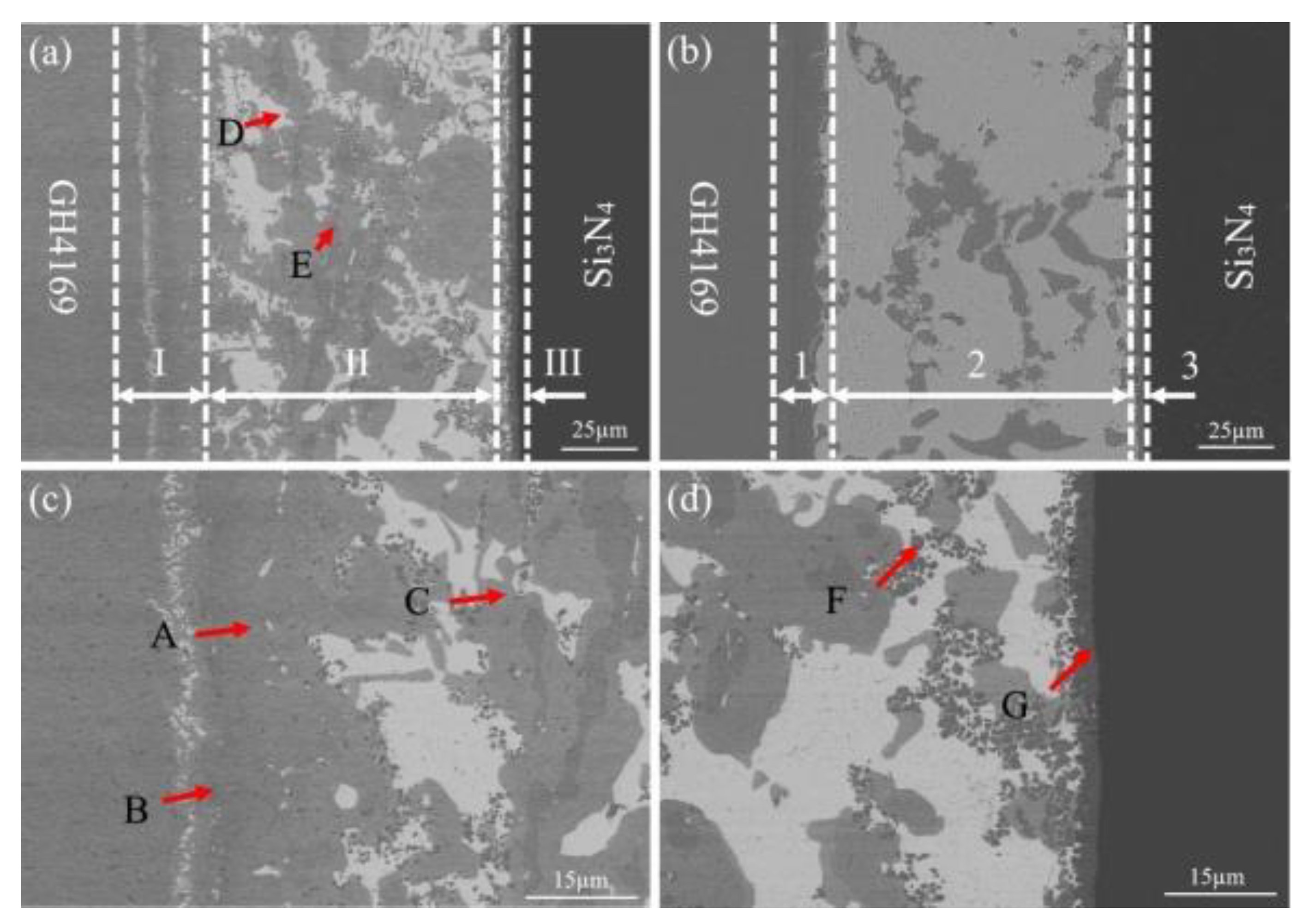

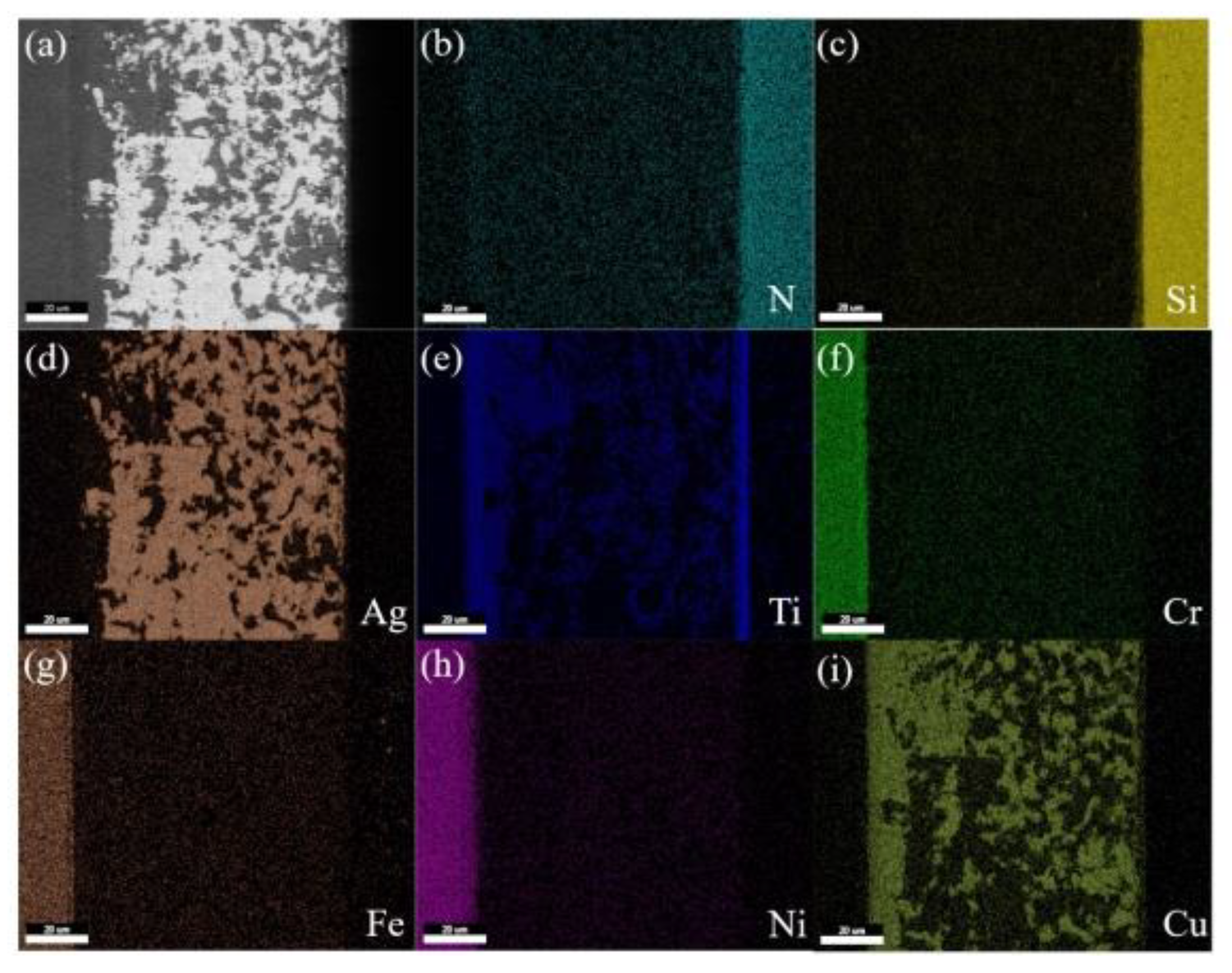
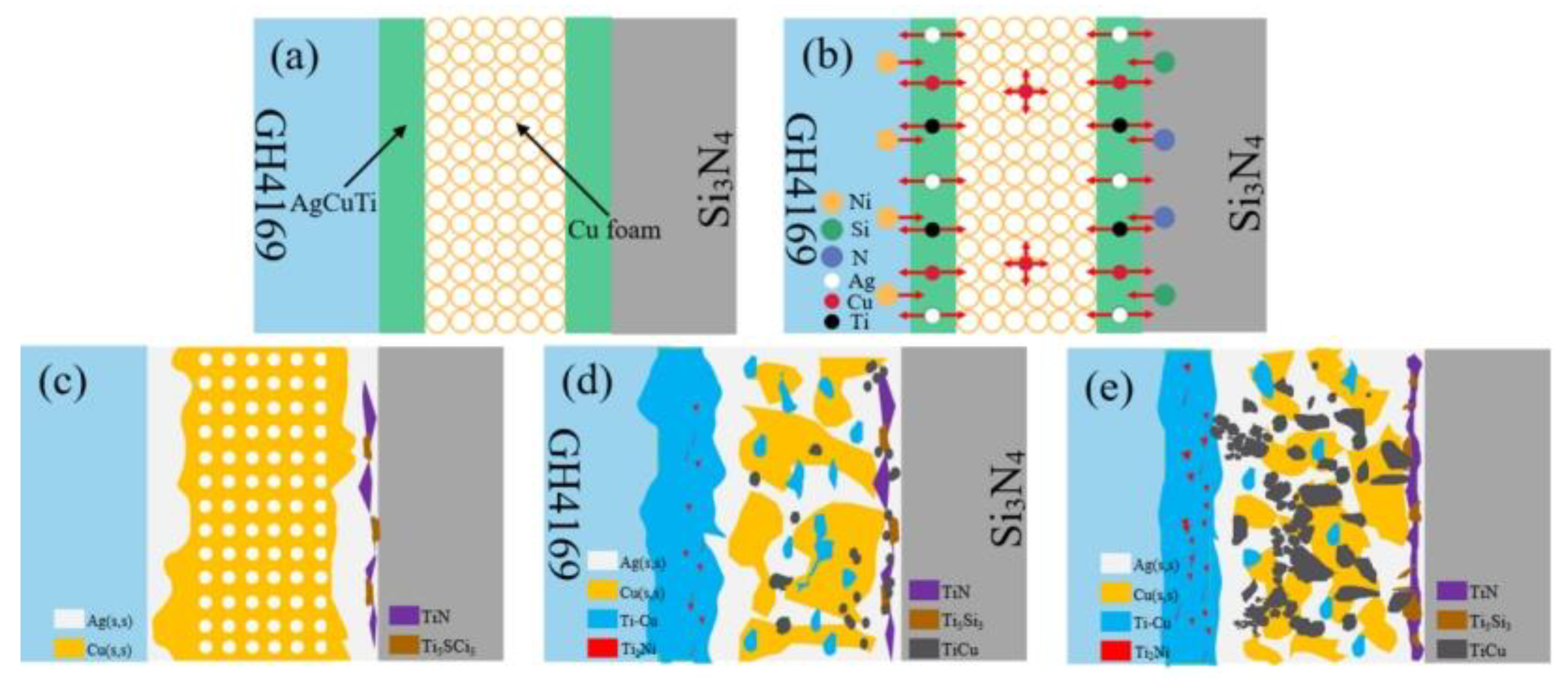
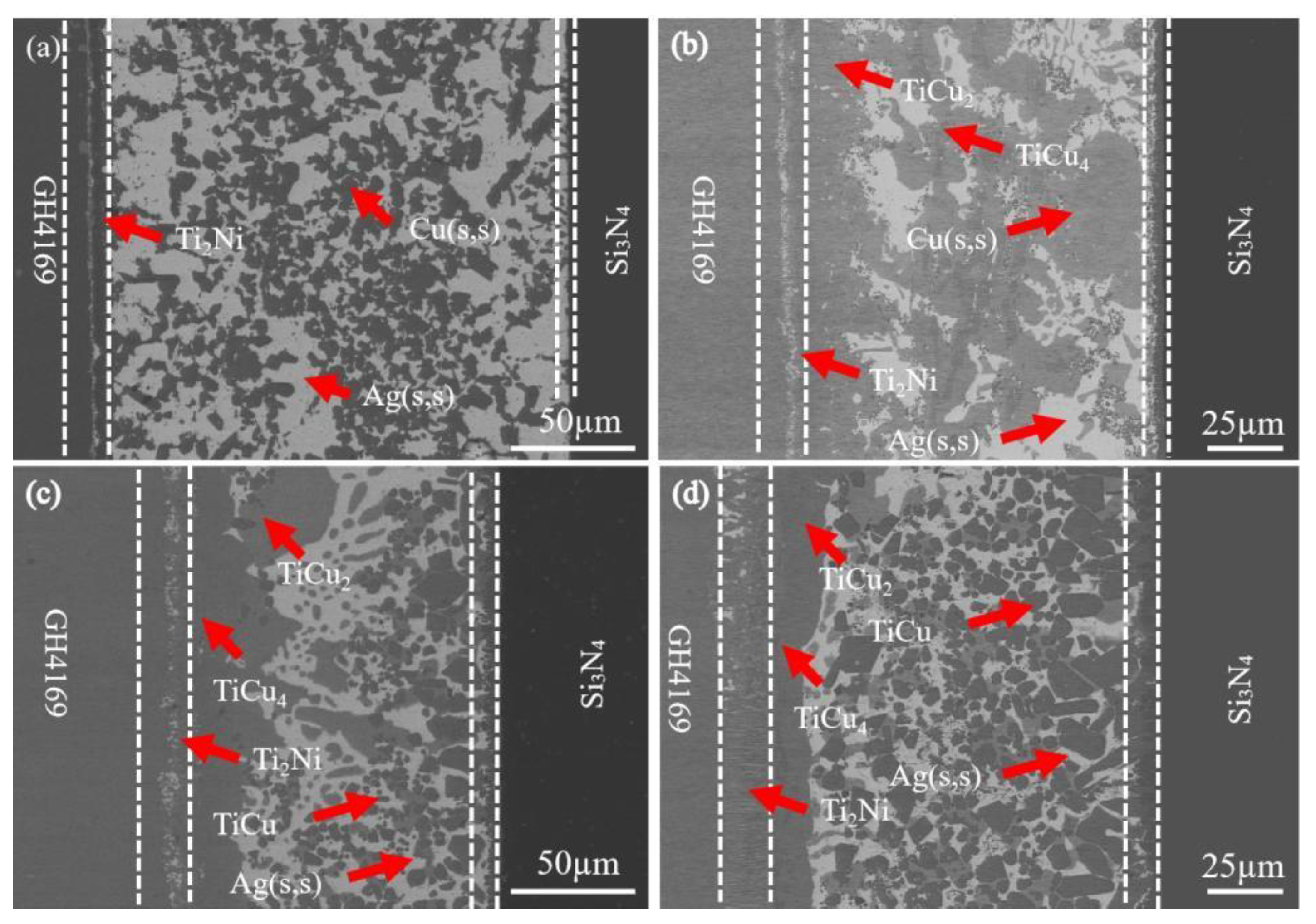



| Ni | Cr | Nb | Mo | Ti | Al | Si | Fe |
|---|---|---|---|---|---|---|---|
| 53.88 | 17.90 | 5.50 | 3.10 | 1.04 | 0.52 | 0.06 | 18.00 |
| Position | Ni | Cr | Fe | Ag | Cu | Ti | Si | n | Possible Phases |
|---|---|---|---|---|---|---|---|---|---|
| A | - | - | - | 6.32 | 64.04 | 29.64 | - | - | TiCu2 |
| B | 24.13 | 5.54 | 7.51 | 1.09 | 10.78 | 50.95 | - | - | Ti2Ni |
| C | - | - | - | 1.49 | 95.74 | 1.76 | 0.95 | 0.06 | Cu (s,s) |
| D | 0.94 | 1.07 | 0.71 | 88.99 | 7.59 | 0.70 | - | - | Ag (s,s) |
| E | - | - | - | 1.32 | 78.42 | 20.26 | - | - | TiCu4 |
| F | 4.01 | 5.98 | 6.02 | 3.54 | 37.10 | 43.55 | - | - | TiCu |
| G | - | - | - | 8.26 | 2.87 | 52.98 | 25.77 | 10.11 | Ti5Si3+TiN |
Publisher’s Note: MDPI stays neutral with regard to jurisdictional claims in published maps and institutional affiliations. |
© 2022 by the authors. Licensee MDPI, Basel, Switzerland. This article is an open access article distributed under the terms and conditions of the Creative Commons Attribution (CC BY) license (https://creativecommons.org/licenses/by/4.0/).
Share and Cite
Yang, X.; Xue, Y.; Wang, S.; Ge, J.; Chen, Y.; Zhang, Z.; Tang, J.; Xiao, J. Microstructure and Mechanical Properties of GH4169 Superalloy and Si3N4 Ceramic Joints Brazed with AgCuTi/Cu foam/AgCuTi Composited Filler. Coatings 2022, 12, 1496. https://doi.org/10.3390/coatings12101496
Yang X, Xue Y, Wang S, Ge J, Chen Y, Zhang Z, Tang J, Xiao J. Microstructure and Mechanical Properties of GH4169 Superalloy and Si3N4 Ceramic Joints Brazed with AgCuTi/Cu foam/AgCuTi Composited Filler. Coatings. 2022; 12(10):1496. https://doi.org/10.3390/coatings12101496
Chicago/Turabian StyleYang, Xiaohong, Yang Xue, Shenggang Wang, Jianya Ge, Yuan Chen, Zhengzhong Zhang, Jinhua Tang, and Junjian Xiao. 2022. "Microstructure and Mechanical Properties of GH4169 Superalloy and Si3N4 Ceramic Joints Brazed with AgCuTi/Cu foam/AgCuTi Composited Filler" Coatings 12, no. 10: 1496. https://doi.org/10.3390/coatings12101496
APA StyleYang, X., Xue, Y., Wang, S., Ge, J., Chen, Y., Zhang, Z., Tang, J., & Xiao, J. (2022). Microstructure and Mechanical Properties of GH4169 Superalloy and Si3N4 Ceramic Joints Brazed with AgCuTi/Cu foam/AgCuTi Composited Filler. Coatings, 12(10), 1496. https://doi.org/10.3390/coatings12101496






